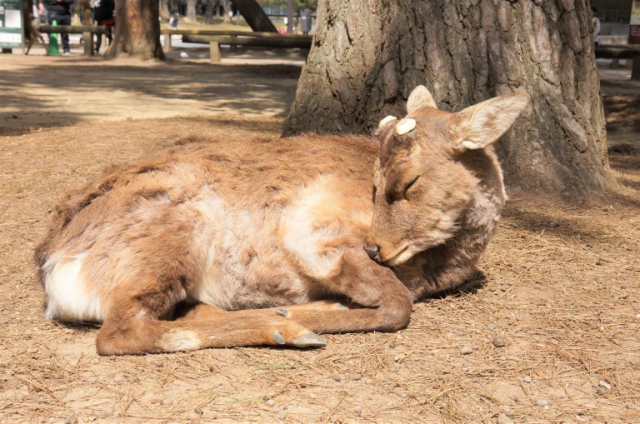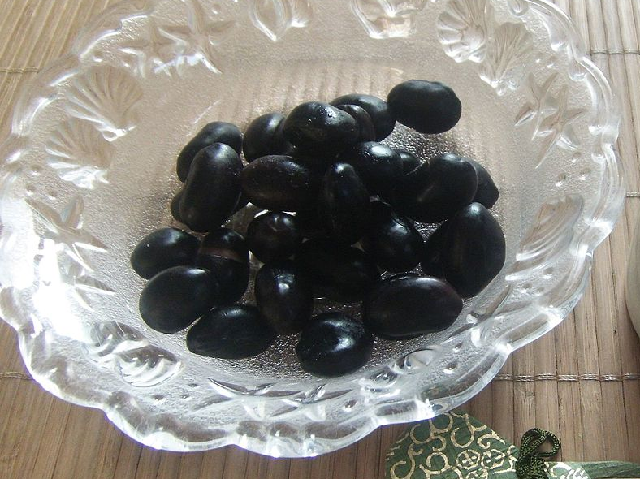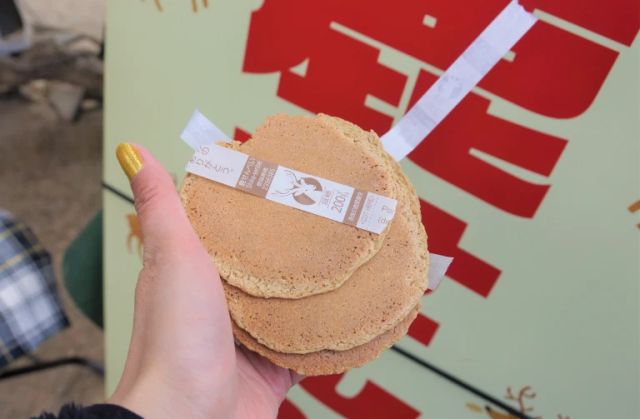
Shape and hardness of animals’ droppings has changed noticeably since a few months ago.
The city of Nara’s most popular tourist attraction is Nara Park, but not necessarily because of the foliage or landscaping. No, what really brings the crowds is the herds of wild yet tame deer that roam free throughout the grounds.
Of course, deer that roam free also poop freely, so a walk around the park offers ample opportunities to see not only the creatures themselves, but also their droppings, and recently there’s been a noticeable change in the quality of the latter.
Ordinarily the pellets from the Nara park deer are on the squishy side. However, in recent weeks local observers have noticed that their animal friends’ poop has become firmer and more consistent in shape, likening its appearance to kuromame, or black soybeans.
▼ Kuromame
The change in the deer’s digestive tract output stems from a change in input, it seems. Throughout the park, vendors sell shika senbei, special rice crackers for visitors to feed to the deer. Though nutritious, the crackers are made from flour and rice bran, which differ from the deer’s natural-environment foods of grasses and nuts. According to Yoshitaka Ashimura, executive director of the Nara Deer Preservation Foundation, eating too large a quantity of the crackers can leave deer feeling especially thirsty, thus causing them to drink more water than they usually would and resulting in diarrhea-like symptoms.
▼ Deer crackers
However, with the coronavirus pandemic severely impacting travel in 2020, Nara Park is receiving far fewer visitors than normal, which in turn means fewer deer crackers being purchased and thus fewer crackers fed to the deer. The drop in visitors has been extra pronounced since Nara Park is particularly popular with foreign visitors, and especially tour groups from China, one of the first countries to experience the effects of the coronavirus pandemic and have its outbound international pleasure travel come to a near-complete stop.
But if Nara’s deer are eating so fewer crackers that it’s affecting their poop, are they still getting enough to eat? The Nara Deer Preservation Foundation believes they are, with Ashimura stressing that the crackers are really like supplementary snacks to the animals, and that they can subsist just fine on naturally growing food sources in the park. “As with anything, balance is important” says Ashimura in discussing the deer’s diet. If anything, the return to a greater proportion of natural fare seems to be a good thing for them, and between this and the giant sea bug in Mie Prefecture that took a dump for the first time in years last month, it’s heartening to know that when we need some good news in these troubled times, we can look to the poop of the animals of Japan.
Source: Asahi Shimbun via Livedoor News via Jin
Top image ©SoraNews24
Insert images: Wikipedia/Indiana jo, SoraNews24
● Want to hear about SoraNews24’s latest articles as soon as they’re published? Follow us on Facebook and Twitter!
Follow Casey on Twitter, where he promises not to tell you what kind of food his poo currently resembles.



 Nara deer “addicted” to rice crackers, lose weight with no tourists to feed them
Nara deer “addicted” to rice crackers, lose weight with no tourists to feed them Increased tourist numbers in Nara Park are affecting the size of its deer population
Increased tourist numbers in Nara Park are affecting the size of its deer population Nara asks visitors to stop feeding the deer
Nara asks visitors to stop feeding the deer Deer in Nara Park outnumber visitors, display baffling summer gathering behaviour
Deer in Nara Park outnumber visitors, display baffling summer gathering behaviour Deer in Nara Park mysteriously disappear during this year’s shikadamari season
Deer in Nara Park mysteriously disappear during this year’s shikadamari season How to order snacks on a Shinkansen bullet train in Japan
How to order snacks on a Shinkansen bullet train in Japan Hello, cosmetics! Clinique teams up with Hello Kitty this summer for first-time collaboration
Hello, cosmetics! Clinique teams up with Hello Kitty this summer for first-time collaboration Demon Slayer: Kimetsu no Yaiba gets new roller coaster attractions and food at Universal Studios Japan
Demon Slayer: Kimetsu no Yaiba gets new roller coaster attractions and food at Universal Studios Japan A visit to the best UFO catcher arcade in the universe!
A visit to the best UFO catcher arcade in the universe! To combat declining birth rate, Japan to begin offering “Breeding Visas” to foreigners
To combat declining birth rate, Japan to begin offering “Breeding Visas” to foreigners Spirited Away train station and submerged tracks attract Ghibli fans around Japan
Spirited Away train station and submerged tracks attract Ghibli fans around Japan Daiso DIY dessert! 100 yen store’s super-easy mochi sweets kit is our new hero
Daiso DIY dessert! 100 yen store’s super-easy mochi sweets kit is our new hero How should you respond when a Japanese person gives you a compliment?
How should you respond when a Japanese person gives you a compliment? New samurai glasses are Japan’s latest weird must-have souvenir
New samurai glasses are Japan’s latest weird must-have souvenir McDonald’s adds new watermelon frappe and fruity macaron to its menu in Japan
McDonald’s adds new watermelon frappe and fruity macaron to its menu in Japan Nintendo history you can feel – Super NES, N64, and GameCube controllers become capsule toys
Nintendo history you can feel – Super NES, N64, and GameCube controllers become capsule toys “The most Delicious Cup Noodle in history” – Japan’s French Cup Noodle wins our heart【Taste test】
“The most Delicious Cup Noodle in history” – Japan’s French Cup Noodle wins our heart【Taste test】 Starbucks releases a cute Frappuccino and Unicorn Cake…but not in Japan
Starbucks releases a cute Frappuccino and Unicorn Cake…but not in Japan Kyoto Tower mascot termination reveals dark side behind cute Japanese characters
Kyoto Tower mascot termination reveals dark side behind cute Japanese characters McDonald’s Japan’s Soft Twist Tower: A phantom ice cream only sold at select branches
McDonald’s Japan’s Soft Twist Tower: A phantom ice cream only sold at select branches Yabai Ramen: What makes this Japanese ramen so dangerous?
Yabai Ramen: What makes this Japanese ramen so dangerous? Finally! Nintendo Japan expands Switch 8-bit controller sales to everybody, Online member or not
Finally! Nintendo Japan expands Switch 8-bit controller sales to everybody, Online member or not Japanese government wants to build luxury resorts in all national parks for foreign tourists
Japanese government wants to build luxury resorts in all national parks for foreign tourists 10 things you should buy at 7-Eleven in Japan
10 things you should buy at 7-Eleven in Japan Studio Ghibli releases anime heroine cosplay dresses that are super comfy to wear
Studio Ghibli releases anime heroine cosplay dresses that are super comfy to wear Woman charged for driving suitcase without a license in Osaka
Woman charged for driving suitcase without a license in Osaka Studio Ghibli unveils My Neighbour Totoro miniature house model
Studio Ghibli unveils My Neighbour Totoro miniature house model Kyoto experiencing problems with foreign tourists not paying for bus fares, but not on purpose
Kyoto experiencing problems with foreign tourists not paying for bus fares, but not on purpose Fighting mild hunger with a Japanese soda that turns into jelly in the stomach【Taste test】
Fighting mild hunger with a Japanese soda that turns into jelly in the stomach【Taste test】 Studio Ghibli’s Howl’s Moving Castle tapestry unveiled in Japan for first time
Studio Ghibli’s Howl’s Moving Castle tapestry unveiled in Japan for first time McDonald’s new Happy Meals offer up cute and practical Sanrio lifestyle goods
McDonald’s new Happy Meals offer up cute and practical Sanrio lifestyle goods Sales of Japan’s most convenient train ticket/shopping payment cards suspended indefinitely
Sales of Japan’s most convenient train ticket/shopping payment cards suspended indefinitely Sold-out Studio Ghibli desktop humidifiers are back so Totoro can help you through the dry season
Sold-out Studio Ghibli desktop humidifiers are back so Totoro can help you through the dry season Japanese government to make first change to romanization spelling rules since the 1950s
Japanese government to make first change to romanization spelling rules since the 1950s Foreigner’s request for help in Tokyo makes us sad for the state of society
Foreigner’s request for help in Tokyo makes us sad for the state of society Ghibli founders Toshio Suzuki and Hayao Miyazaki contribute to Japanese whisky Totoro label design
Ghibli founders Toshio Suzuki and Hayao Miyazaki contribute to Japanese whisky Totoro label design Doraemon found buried at sea as scene from 1993 anime becomes real life【Photos】
Doraemon found buried at sea as scene from 1993 anime becomes real life【Photos】 Tokyo’s most famous Starbucks is closed
Tokyo’s most famous Starbucks is closed Princesses, fruits, and blacksmiths: Study reveals the 30 most unusual family names in Japan
Princesses, fruits, and blacksmiths: Study reveals the 30 most unusual family names in Japan Why isn’t there more deer poo in Nara Park? This very strange museum has the answer【Photos】
Why isn’t there more deer poo in Nara Park? This very strange museum has the answer【Photos】 Nara unveils new vending machines that sell deer crackers
Nara unveils new vending machines that sell deer crackers Nara deer dies with four kilos of plastic in its stomach, tourists cautioned to feed animals properly
Nara deer dies with four kilos of plastic in its stomach, tourists cautioned to feed animals properly Nara Park’s first baby deer of the year has been born, is totally adorable【Video】
Nara Park’s first baby deer of the year has been born, is totally adorable【Video】 Nara considering increasing number of deer that can be killed each year, expanding culling zone
Nara considering increasing number of deer that can be killed each year, expanding culling zone Nara deer leave park, head to station for food as tourist numbers tumble due to coronavirus
Nara deer leave park, head to station for food as tourist numbers tumble due to coronavirus Nara deer stampede into marathon, hit runner in their path
Nara deer stampede into marathon, hit runner in their path Nara deer shikadamari mystery deepens as tourists return to Nara park
Nara deer shikadamari mystery deepens as tourists return to Nara park Adorable bowing deer in Japan shows you can be concurrently cute and courteous【Video】
Adorable bowing deer in Japan shows you can be concurrently cute and courteous【Video】 Nara’s “deer cookie” rice crackers get their first price increase in 28 years
Nara’s “deer cookie” rice crackers get their first price increase in 28 years During Golden Week rush, Nara deer so overwhelmed with rice crackers they wear them as hats
During Golden Week rush, Nara deer so overwhelmed with rice crackers they wear them as hats Nara, Japanese city famous for its streets of tame deer, begins culling program within city
Nara, Japanese city famous for its streets of tame deer, begins culling program within city Deer killed by man with axe in Nara
Deer killed by man with axe in Nara Why deer are drawn to train tracks, and how Japan is solving the problem with this simple block
Why deer are drawn to train tracks, and how Japan is solving the problem with this simple block Nara’s deer continue their summertime tradition of commandeering one of the city’s streets
Nara’s deer continue their summertime tradition of commandeering one of the city’s streets
Leave a Reply